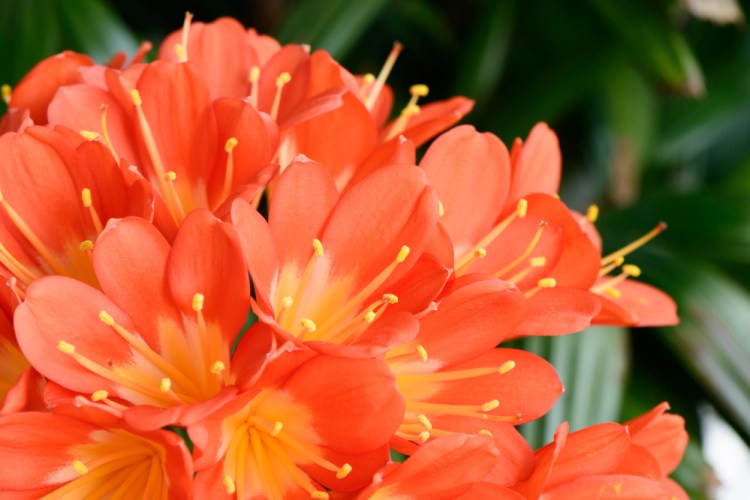Clivia is a houseplant that my wife, Nancy, with occasional help from me, has grown since shortly after we moved into our house in 1975. Recently, I received a link to a blog that mentioned that White Flower Farm, a high-end nursery in Connecticut, was selling clivias for up to $900 a plant. Oh my! (They now are listed as sold out, except for two varieties at $300 a plant.)
Nancy’s first clivia came from her grandmother, Stella, as did many of our plants. The roots of Stella’s clivia had grown so large that the pot broke, so we assisted her in dividing and repotting the plant. Our reward was one of the divisions.
It did well for us, blooming in mid to late winter with striking orange blossoms and displaying dark green strap-like leaves the rest of the year.
Later, Nancy bought another clivia, with wider leaves and paler orange blossoms, at a garden-club plant sale. We don’t know the cultivar names of either of our two plants.
The common name of clivia is listed as either Natal lily or bush lily (The previously used common name, Kaffir lily, is considered racist, as “Kaffir” is a perjorative term for South African blacks). The blossoms come in yellow as well as orange.
Eliot Wadsworth of White Flower Farm said that his nursery starts selling clivias in fall and continues selling them until spring. Prices are high, he added, for a reason.
“It is not an easy plant to propagate, and a flowering clivia will be several years old,” Wadsworth said. “It takes a lot of inputs to get a plant up to flowering size.”
White Flower Farm has a relationship with Longwood Gardens in Pennsylvania, which is one of the leaders in breeding clivias, and most of the clivias that are sold by the nursery – including the $900 specimens – come from the Longwood program.
Byron Martin, owner and horticulturist at Logee’s, another Connecticut nursery that sells by catalog and online, says clivias need a little neglect before they’ll come into bloom, which mimics their natural growth patterns.
“In their native region of South Africa, they go through a period of little or no water and winter temperatures cool down into the 30s and 40s,” Martin said. “They also grow on thin soil so the dry spell is quite pronounced.”
What that translates to in the home is cool night temperatures and limited watering from October or November until the flower buds are visible – about five weeks.
Logee’s carries two clivia in its online catalog, a yellow one in a four-inch pot for $24.95 and an orange one in a 2.5-inch pot for $14.95. They ship year-round as long as the temperature isn’t below freezing. (These cost less because they are smaller and younger; also, they may need more time to reach blossom age, and the variety may be less rare).
While hybridizers grow clivia from seed, most are developed by dividing the plants, which is a time-consuming process. Martin said that as far as he knows, the plants have not been created through tissue culture.
Clivia like to be snug in the pot, according to Wadsworth. When you divide and replant them, he said, “they tend to sulk a bit.”
Nancy divides and repots her clivia whenever she sees roots come out the drainage holes at the bottom of the pot – and sometimes even growing out of the soil at the top of the pot. She knows at that point that if she doesn’t repot them soon, the pressure of the roots will crack the pot.
Maine shoppers will have to look hard to find clivias at local nurseries and garden centers. I called eight of the larger stores; one directed me to Snug Harbor Farm in Kennebunk, which turns out to sell one yellow and one orange variety in 10- to 12-inch pots, each for $100.
Skillins said they usually start selling clivia as they are beginning to bloom. Longfellow Gardens in Manchester said they do sell them, but they had none in stock when I called in mid-November.
If you do find one while plant shopping this winter, you won’t regret paying the price and bringing it home. Their blossoms are gorgeous, and the leaves are lush even when the plants aren’t in bloom. They live seemingly forever and after a decade or so you can divide them so you’ll have more than one clivia. Finally, to be perfectly honest, it’s nice to own a plant that most people don’t have and that many don’t even know exists.
Tom Atwell is a freelance writer gardening in Cape Elizabeth. He can be contacted at 767-2297 or at: tomatwell@me.com.
Send questions/comments to the editors.



Comments are no longer available on this story